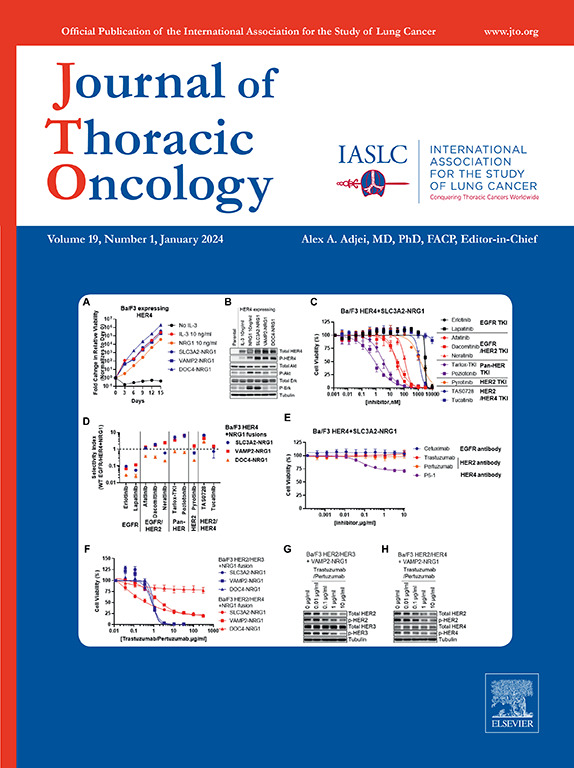无论辅助治疗与否,接受新辅助化疗免疫疗法的可切除NSCLC患者在完全或主要病理反应后的无事件生存期均有所改善:一项系统综述和个体患者数据荟萃分析。
IF 21
1区 医学
Q1 ONCOLOGY
引用次数: 0
摘要
背景:新辅助化疗免疫疗法重塑了可切除NSCLC的治疗格局,但病理反应的预后意义仍不明确。我们进行了一项系统回顾和个体患者数据(IPD)荟萃分析,以评估达到pCR或MPR对EFS的影响,并评估辅助免疫疗法的影响:我们对可切除NSCLC患者新辅助或围手术期抗PD-(L)1联合铂类化疗的前瞻性临床试验进行了IPD荟萃分析。IPD是从纳入研究的pCR和/或MPR的Kaplan-Meier曲线中提取的。考虑到意向治疗人群(ITT)和切除人群,比较了获得 pCR 或 MPR 患者与未获得 pCR 或 MPR 患者的生存结果:结果:在ITT人群中,获得pCR或MPR与EFS的改善有关(pCR,HR分别为0.13;MPR,HR为0.18),获得pCR和MPR的患者24个月的EFS率分别为94%和88%。与pCR状态无关,接受包括辅助免疫疗法的实验组治疗的患者的EFS相似:结论:我们的研究显示,新辅助化疗免疫疗法后获得 pCR 或 MPR 的患者的 EFS 有明显改善。肿瘤切除后使用辅助免疫疗法与EFS的改善无关。本文章由计算机程序翻译,如有差异,请以英文原文为准。
Improved Event-Free Survival After Complete or Major Pathologic Response in Patients With Resectable NSCLC Treated With Neoadjuvant Chemoimmunotherapy Regardless of Adjuvant Treatment: A Systematic Review and Individual Patient Data Meta-Analysis
Introduction
Neoadjuvant chemoimmunotherapy has reshaped the treatment landscape for resectable NSCLC, yet the prognostic significance of pathologic response remains unclear. We conducted a systematic review and individual patient data (IPD) meta-analysis to evaluate the impact of achieving pathologic complete response (pCR) or major pathologic response (MPR) on event-free survival (EFS) and assessed the influence of adjuvant immunotherapy.
Methods
We performed an IPD meta-analysis of prospective clinical trials on neoadjuvant or perioperative anti–programmed death-ligand 1 in combination with platinum-based chemotherapy in patients with resectable NSCLC. The IPD was extracted from Kaplan-Meier curves for pCR and MPR from the included studies. Survival outcomes were compared between patients achieving pCR or MPR and those who did not, considering both intention-to-treat and resected populations.
Results
Achieving pCR or MPR was associated with improved EFS in the intention-to-treat population (pCR, hazard ratio = 0.13; MPR, hazard ratio = 0.18, respectively) with a 24 months EFS rate of 94% and 88% for patients who achieved pCR and MPR, respectively. Independently from pCR status, patients who were treated in an experimental arm that included adjuvant immunotherapy had similar EFS.
Conclusions
Our study reported a strong EFS improvement in patients who achieved either pCR or MPR after neoadjuvant chemoimmunotherapy. The use of adjuvant immunotherapy after tumor resection was not associated with improved EFS.
求助全文
通过发布文献求助,成功后即可免费获取论文全文。
去求助
来源期刊

Journal of Thoracic Oncology
医学-呼吸系统
CiteScore
36.00
自引率
3.90%
发文量
1406
审稿时长
13 days
期刊介绍:
Journal of Thoracic Oncology (JTO), the official journal of the International Association for the Study of Lung Cancer,is the primary educational and informational publication for topics relevant to the prevention, detection, diagnosis, and treatment of all thoracic malignancies.The readship includes epidemiologists, medical oncologists, radiation oncologists, thoracic surgeons, pulmonologists, radiologists, pathologists, nuclear medicine physicians, and research scientists with a special interest in thoracic oncology.
 求助内容:
求助内容: 应助结果提醒方式:
应助结果提醒方式:


